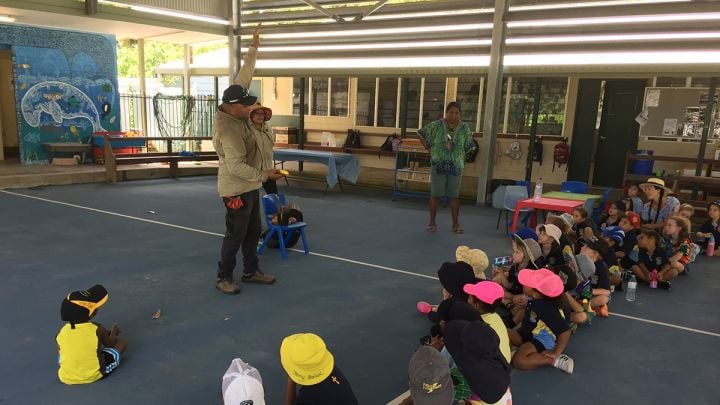
The Torres Strait Regional Authority (TSRA) visited Hammond Island recently to share some fun lessons in gardening maintenance at Our Lady of the Sacred Heart (OLSH) school.
The TSRA’s Environmental Management team works closely with schools to encourage students to develop their interest and understanding of sustainable horticulture.
TSRA Chairperson, Mr Napau Pedro Stephen AM, said that it is important for the schools of the Torres Strait region to build their skills in both new and traditional environmental concepts.
“The TSRA’s Environmental Management (Land) team teaches its gardening workshops through a combination of traditional ecological knowledge which is learned within their own families and communities along with modern western and scientific concepts taught in schools, Mr Stephen said.
“The Land teams George Saveka, Dale Morris and Ilana Foster visited Hammond Island to deliver some very hands-on lessons with students as they prepared their own garden beds.
“The lessons involve the students in all stages of the processes, from mixing together soil and fertiliser to planting a variety of seedlings in garden beds and pots.
“It also introduces them to different crops such as mint, ginger and capsicum as well as zucchini, beetroot, lemon grass and a mix of bee attracting flowers.”
Students from Prep to year 4 at OLSH learnt about the value of growing your own fruit, vegetables and herbs from the garden to the kitchen; from harvesting cassava, to maintaining the ground, feeding Banana plants; and some helpful cooking activities with home grown basil to make Pesto and Cassava for Sop Sop.
Sustainable Horticulture specialist Mr George Saveka provided a presentation to the children, teachers and parents using different types of root vegetables (Yam or Kumala); white, purple and orange sweet potato, cassava (Taro or Manihot), and jap pumpkin to explain the types of vegetables that are used as traditional foods or can be easily grown in the Torres Strait.
These vegetables were also used to create a traditional dish called Sop Sop, garnished with banana.
The students enjoyed making and tasting the traditional dish as well as learning how you can produce your own food from the garden to your kitchen.
Working with cassava
Harvesting the traditional vegetable cassava requires the stems be planted in December in preparation for the expected wet season.
- Taking up to six months to grow, vegetables are ready to harvest in July.
- For greater success when growing cassava, it is best to plant the stems at a 45 degree angle in soil that is well aerated, tilled and mounded.
- The stems will produce larger root vegetables if the ground is loose and deep.
- Signs that the vegetable is ready to harvest is when the soil on the crest of the mound begins to crack.
Unfortunately, the cassava planted last year for the school did not produce the root vegetable desired, but gardening is also about learning what works best for your garden, so the students are trying again.

